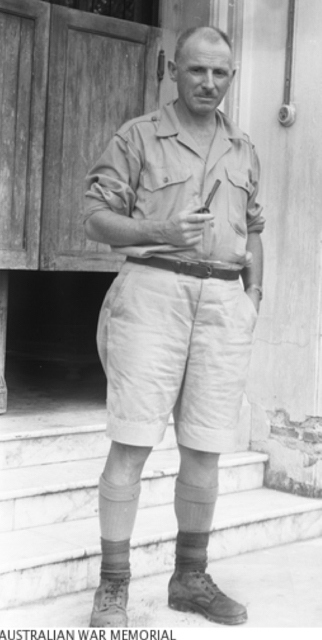The main causes of POW deaths were maltreatment, starvation, overwork and disease. The work itself was very often gruelling, and dangerous. They worked excessively long hours whilst sick, without medicines with very, very little food and at times no rest days. They were subjected to unexpected brutality.
WX9004 Albert Cryer was evacuated with a large number of sick from ‘D’ Force S Battalion working on Burma-Thai Railway Hellfire pass region to Kanu 1 River Camp – which was not a camp with shelter, it was a staging post for the sick to barge south down the river to POW hospital camps. It was while waiting to board a barge that very ill Albert Cryer died of typhus on 28 July 1943 aged 32 years.

Above: Albie Cryer
While at 75 Kilo camp, and working as solo doctor, Albert Coates, Head Surgeon of AIF was incapacitated with scrub-typhus and many of the men thought he would die. Although he could not stand, the Japanese sent him to run a new hospital camp 55 kilo at Kohn Kuhn where the main body of sick and injured would be taken. Coates was so sick, he had to be carried around the camp site while construction was completed and he examined the sick. He was forever grateful to two men who looked after him during his illness, Harold Buckley, who was suffering from malaria himself, and a Dutchman, Capt C J Van Bentinck who also provided great care.’

Other members of ‘D’ Force S Battalion to die of Typhus included:
WX8639 Joseph John (JJ) LYNCH, ‘D’ Force S Btn died cholera and typhus at Kanu 1 River Camp 1 Aug 1943 aged 34 years. Just a few days after Albert Cryer. He had been evacuated with large number sick POWs and was waiting for a barge to be transported.

WX8820 Wallace Patrick MCCUDDEN from Esperance was evacuated from Burma-Thai Railway and died at Chungkai Hospital Camp 21 Aug 1943 of cardiac beri beri and Typhus aged 36 years.

SCRUB TYPHUS is a very serious disease.
Scrub typhus is a disease caused by bacteria called Orientia tsutsugamushi, which is in the rickettsia family.
How it is spread
The bacteria infect people when they are bitten (usually painlessly) by an infected larval mite called
Leptotrombidium deliense. The mite is very small (0.2 to 0.4mm) and can often only be seen through a microscope or magnifying glass.
The mites live in grassland areas at the edge of dense monsoon forests or forested creeks. Mites usually feed
on marsupials and other native animals such as rats but they can attach to passing humans and bite for a blood meal.
Scrub typhus cannot spread from one person to another.
Symptoms
The symptoms usually occur within 1 to 2 weeks of being bitten. They may include fever, chills, sweating,
headache, muscle aches, swollen glands, nausea/vomiting and a skin rash. The bite site often ulcerates and becomes red with a central black scab, called an “eschar”. The bite site may be on the buttocks or genitalia, including when people have been bitten while sitting, and in the armpit.
Where is the disease found
Scrub typhus is found in the Asia-Pacific region including northern Australia. The endemic area extends from. south-eastern Siberia and northern Japan, through eastern and south-east Asia, to Vanuatu in the east and Pakistan in the west. Other countries may have small foci. North Thailand has the highest prevalence of disease.
There have been numerous reported cases of infection in the Top End of the Northern Territory since 1990.
We wish to acknowledge much of the above information is taken from NT Health Fact Sheet.
